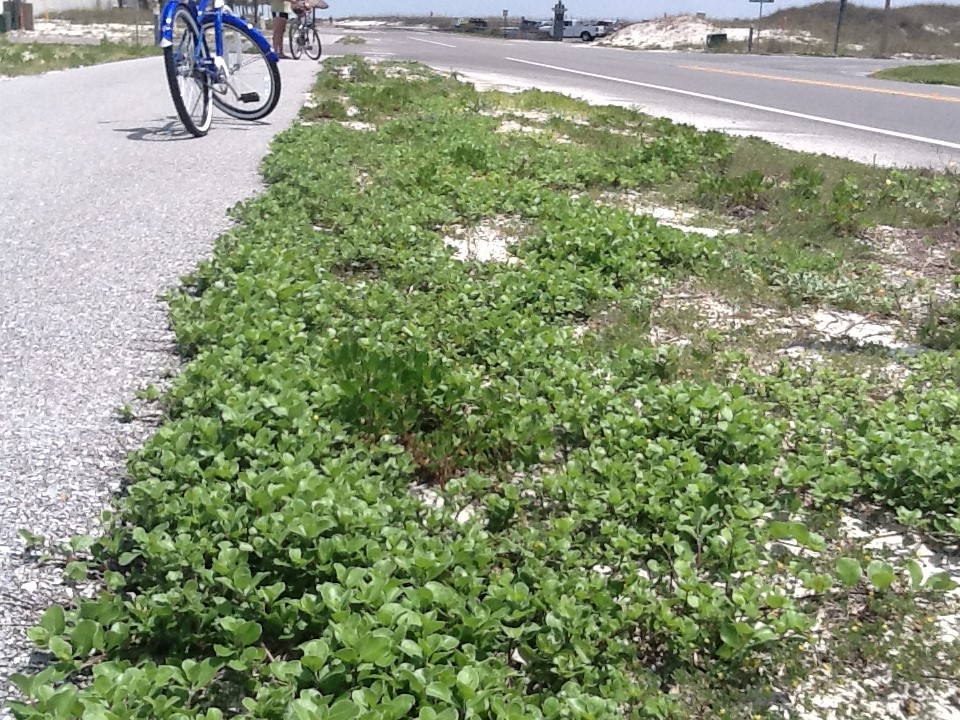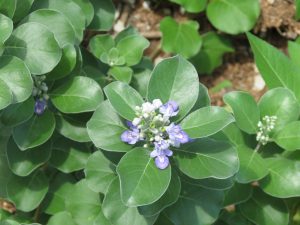The quick answer…
No
So, why write this?
For two reasons…
- To let everyone know how the battle against this invasive plant in the panhandle is going
- To encourage everyone along the coast to keep searching, reporting, and removing it.
Can you actually eradicate an invasive species?
MAYBE
But… you must find and begin to manage it early. What many call Early Detection Rapid Response (EDRR) – and beach vitex is just that in the state of Florida.
For those not familiar with the plant, it is called beach vitex (Vitex rotundifolia). It is native to the Pacific coast of Asia, extending from North Korea to Australia. This suggest that it can tolerate cold weather, something that has kept many south Florida invasive species at bay in the Florida panhandle, but not this one.

It likes dry sandy soils and open sunny areas – our beaches are perfect. It begins with a taproot and forms runners that cross the surface of the sand in all directions, ALMOST 360°, but not quite. The runners are herbaceous at first and form blueish-green ovate shaped leaves and a cluster of beautiful lavender flowers in the spring and early summer. As the plant grows it becomes more woody and can form a shrub growing between three and four feet high. In the fall, after the cold fronts begin, the flowers become small gray seed pods. Each pod contains four seeds, and the plant can produce up to one million seeds/m2. These are viable for several months and can tolerate salt water for that period as well.
The plant may have been introduced as early as 1955 but was certainly here by the 1980s. During that period the state of South Carolina decide to try it in dune restoration after a series of strong hurricanes. That is when it raised its ugly head and let us know that it is not a plant we want on our coast.

It grows aggressively forming large monocultures within the dunes. It is allelopathic, meaning it releases chemical compounds that can cause the decline of plants around it, this would include our beloved sea oats. Being a taproot plant, not a fibrous one like the sea oat, the integrity of the dunes to protect from storms is weakened. Becoming a shrub, it can also shade the sand keeping other native plants from sprouting and could impact both the survival of sea turtle hatchings and the listed beach mice around the Gulf.
The plant was first reported to us in Pensacola around 2014 by a birding couple we know in Gulf Breeze, Florida. It was growing on Fair Point near their home. They told us they had it under control on their property but that it was most likely coming from Pensacola Beach on Santa Rosa Island – so, we took a look – and we found it.
Since that time, we have found it in other coastal counties along the Florida panhandle and are trying hard to (1) remove it as fast as we find it and (2) educate others so they can help.
We just completed our annual survey event we call HALLOWEED. We only surveyed Pensacola Beach and the portion of the Gulf Islands National Seashore called Naval Live Oaks in Gulf Breeze. Here are the results from the 2022 HALLOWEED…
12 volunteers worked between 2-4 hours logging 41 total hours last Friday.
We have updates on the Pensacola Beach Survey – Naval Live Oaks results coming soon!!
95 sites of beach vitex in the bay area
57 of those (60%) are on Pensacola Beach (surveyed)
25 (26%) are at Naval Live Oaks (will need to be updated)
6 (6%) are on Navarre Beach (were not surveyed)
3 (3%) are in Gulf Breeze (not surveyed)
2 (2%) are on Perdido Bay (not surveyed)
2 (2%) are on Perdido Key (not surveyed)
Of the 57 sites on Pensacola Beach…
30 (32% of the total; 52% of sites on Pensacola Beach) are on NE Pensacola Beach – north of Via DeLuna Drive – and east of Casino Beach
24 (25% of the total; 42% of sites on Pensacola Beach) are on SE Pensacola Beach
2 (2% of the total; 4% of sites on Pensacola Beach) are on NW Pensacola Beach
1 (1% of the total; 2% of the sites on Pensacola Beach) are on SW Pensacola Beach
All 3 sites on WEST Pensacola Beach are GREEN – have been removed and have not returned; no survey of the west end of the island was conducted today – but based on current log – there is no beach vitex on west end of Pensacola Beach.
Of the 54 sites on the east end –
34 (63%) are on private property
20 (21%) are on public lands
Of the private properties –
24 (71%) have been either completely removed or have been treated and in the process.
10 (29%) have not been removed or treated – it is not illegal to have beach vitex and is up to the homeowner whether they want to manage it or not.
Of the public lands –
15 (75%) have either been completely removed and have not returned; or have been treated.
5 (25%) have not been removed or treated – it is up to us to make this change – and we will next spring.
We do hope to get a survey of Perdido Key completed by the end of the year.
We are also planning another annual removal event we call WEED WRANGLE for early spring 2023. We will need volunteers help to do this. If interested in helping, contact Rick O’Connor (roc1@ufl.edu; 850-475-5230 ext.1111).
As for the rest of the panhandle here are the records in EDDMapS as of October 2022.
Escambia County FL – 44 records
Santa Rosa County FL – 4 records
Okaloosa County FL – 31 records
Walton County FL – 0 records
Bay County FL – 0 records
Gulf County FL – 1 record
Franklin County FL – 4 records
Wakulla County FL – 0 records
Jefferson County FL – 0 records
We are SURE this is under reported and we need your help to update these records as well as remove these plants before we are out of the EDRR phase and eradication is no longer an option. Again, contact me (Rick O’Connor) at the contact above if you would like to help.
- Rattlesnakes on Our Barrier Islands; Part 3 – Envenomation - December 22, 2025
- St. Joe Red Tide Claiming Terrapins - December 15, 2025
- The 2025 Snake Watch Report for the Pensacola Bay Area - December 15, 2025
